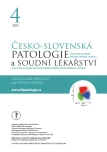The role of flow cytometry in the investigation of lymph node and extranodal lymphatic tissue specimen
Authors:
Tomáš Zajíc 1; Jana Včeláková 2; Vít Campr 2; Tomáš Jirásek 3
Authors‘ workplace:
Oddělení klinické mikrobiologie a imunologie, Centrum laboratorní medicíny, Krajská nemocnice Liberec a. s.
1; Ústav patologie a molekulární medicíny 2. LF UK a Fakultní nemocnice Motol, Praha
2; Oddělení patologie, Centrum PATOS, Krajská nemocnice Liberec, a. s.
3
Published in:
Čes.-slov. Patol., 59, 2023, No. 4, p. 168-176
Category:
Reviews Article
Overview
Although flow cytometry examination of lymphoproliferation in lymph nodes provides minimal morphological information, apart from indicative determination of cell size and granularity, and completely loses topographical information. However, the great advantage of this method is the speed of determining and combination of investigated antigens, where the expression intensities of individual markers are no less important. This is absolutely crucial for hematological malignancies, where different diseases can look very similar at the morphological level and variations in the appearance of tumour cells can be minimal. When diagnosing lymphomas, the combination of histology and immunohistochemistry with flow cytometry provides a more comprehensive view for the interpretation of individual findings. The aim of this article is to provide basic information about the examination of lymph nodes and extranodal tissue by flow cytometry as a starting point for the collaboration of the pathologist and the cytometrist.
Keywords:
Flow cytometry – lymph node – Lymphoproliferative disorder
Sources
- Manďáková P, Čandová J. Imunofenotypizace průtokovou cytometrií v patologii. Cesk Patol 2013; 49(4): 126–130.
- Gorczyca W. Flow cytometry in neoplastic hematology: Morphologic--immunophenotypic correlation (2nd ed.). Informa Healthcare. London. 2010.
- Alaggio R, Amador C, Anagnostopoulos I, et al.The 5th edition of the World Health Organization classification of haematolymphoid tumours: Lymphoid neoplasms. Leukemia 2022; 36: 1720–1748.
- Craig FE, Foon KA. Flow cytometric immunophenotyping for hematologic neoplasms. Blood 2008; 111: 3941–3967.
- Seegmiller AC, Hsi ED, Craig FE. The current role of clinical flow cytometry in the evaluation of mature B-cell neoplasms. Cytometry B Clin Cytom 2019; 96: 20–29.
- Debord C, Wuilleme S, Eveillard M, et al. Flow cytometry in the diagnosis of mature B‐cell lymphoproliferative disorders. Int J Lab Hematol 2020; 42: 113–120.
- Costa ES, Pedreira CE, Barrena S, et al. Automated pattern-guided principal component analysis vs expert-based immunophenotypic classification of B-cell chronic lymphoproliferative disorders: a step forward in the standardization of clinical immunophenotyping. Leukemia 2010; 24(11): 1927-33.
- van Dongen JJ, Lhermitte L, Böttcher S, et al. EuroFlow antibody panels for standardized n-dimensional flow cytometric immunophenotyping of normal, reactive and malignant leukocytes. Leukemia 2012; 26(9): 1908-75.
- Schwock J, Geddie WR. Diagnosis of B-cell non-hodgkin lymphomas with small-/intermediate-sized cells in cytopathology. Patholog Res Int 2012; 2012: 164934.
- Scott GD, Lau HD, Kurzer JH, Kong CS, Gratzinger DA. Flow immunophenotyping of benign lymph nodes sampled by FNA: Representative with diagnostic pitfalls. Cancer Cytopathol 2018; 126(9): 797-808.
- Chi, P-D, Freed, NS, Wake L, et al.A simple and effective method for flow cytometric study of lymphoid malignancies using needle core biopsy specimens. Cytometry B Clin Cytom 2018; 94: 793–799.
- Barroca H, Marques C. A basic approach to lymph node and flow cytometry fine-needle cytology. Acta Cytologica 2016; 60(4): 284–301.
- Martig DS, Fromm JR. A comparison and review of the flow cytometric findings in classic Hodgkin lymphoma, nodular lymphocyte predominant Hodgkin lymphoma, T cell/histiocyte rich large B cell lymphoma, and primary mediastinal large B cell lymphoma. Cytometry B Clin Cytom 2022; 102(1): 14–25.
- Grewal RK, Chetty M, Abayomi EA, Tomuleasa C, Fromm, JR. Use of flow cytometry in the phenotypic diagnosis of hodgkin‘s lymphoma. Cytometry B Clin Cytom 2019; 96: 116–127.
- Rawstron AC, Kreuzer KA, Soosapilla A, et al. Reproducible diagnosis of chronic lymphocytic leukemia by flow cytometry: An European Research Initiative on CLL (ERIC) & European Society for Clinical Cell Analysis (ESCCA) Harmonisation project. Cytometry B Clin Cytom 2018;94:121–128.
- Hedley BD, Cheng G, Keeney M, et al. A multicenter study evaluation of the ClearLLab 10C panels. Cytometry B Clin Cytom 2021; 100: 225–234.
- Hoffmann J, Rother M, Kaiser U, et al. Determination of CD43 and CD200 surface expression improves accuracy of B-cell lymphoma immunophenotyping. Cytometry B Clin Cytom 2020; 98: 476–482.
- Berg H, Otteson GE, Corley H, et al. Flow cytometric evaluation of TRBC1 expression in tissue specimens and body fluids is a novel and specific method for assessment of T-cell clonality and diagnosis of T-cell neoplasms. Cytometry B Clin Cytom 2021; 100: 361–369.
- Shi M, Jevremovic D, Otteson GE, Timm MM, Olteanu H, Horna P. Single antibody detection of T-cell receptor αβ clonality by flow cytometry rapidly identifies mature T-cell neoplasms and monotypic small CD8-positive subsets of uncertain significance. Cytometry B Clin Cytom 2020; 98: 99–107.
- Muñoz-García N, Lima M, Villamor N, et al. Anti-TRBC1 antibody-based flow cytometric detection of T-cell clonality: Standardization of sample preparation and diagnostic implementation. Cancers (Basel) 2021; 13(17): 4379.
- Cardoso CC, Auat M, Santos-Pirath IM, et al. The importance of CD39, CD43, CD81, andCD95 expression for differentiating B cell lymphoma by flow cytometry. Cytometry B Clin Cytom 2018; 94: 451–458.
- Novikov ND, Griffin GK, Dudley G, et al. Utility of a simple and robust flow cytometry assay for rapid clonality testing in mature peripheral T-cell lymphomas. Am J Clin Pathol. 2019; 151: 494–503.
- Jevremovic D, Olteanu H. Flow cytometry applications in the diagnosis of T/NK-cell lymphoproliferative disorders. Cytometry B Clin Cytom 2019; 96: 99–115.
Labels
Anatomical pathology Forensic medical examiner ToxicologyArticle was published in
Czecho-Slovak Pathology

2023 Issue 4
Most read in this issue
- Flow cytometry immunophenotyping of the bone marrow samples for the diagnosis of hematologic neoplasms
- The role of flow cytometry in the investigation of lymph node and extranodal lymphatic tissue specimen
- Fat-poor spindle cell lipoma: a case report
- Composite follicular lymphoma and in situ mantle cell neoplasia of lymph node: identification based on flow cytometry investigation
